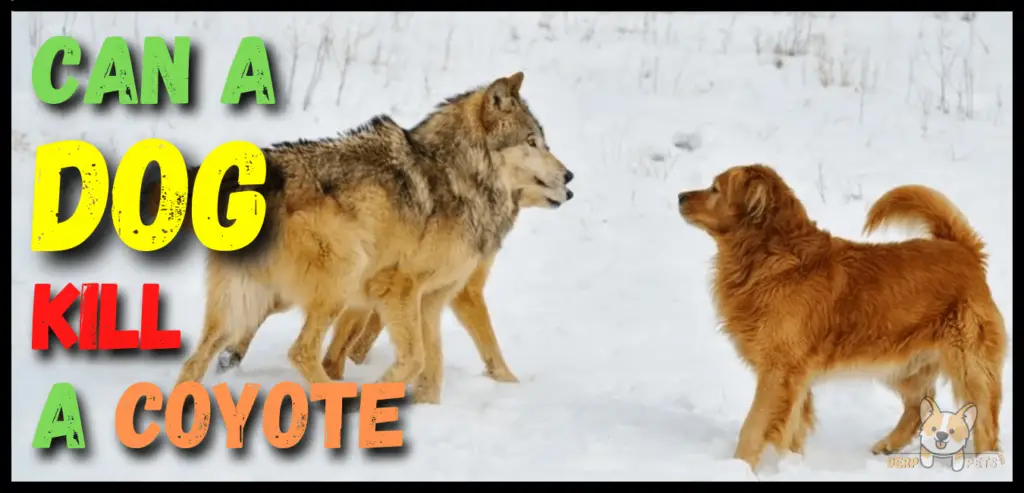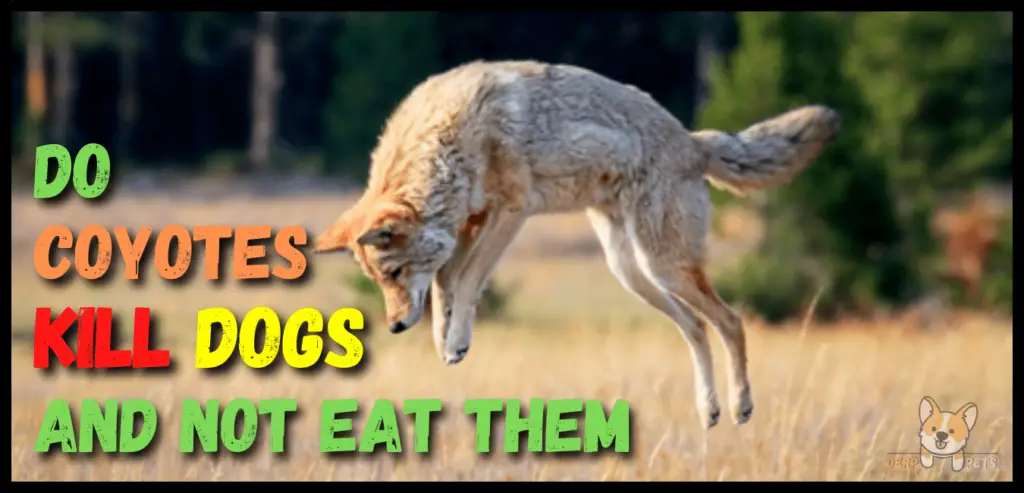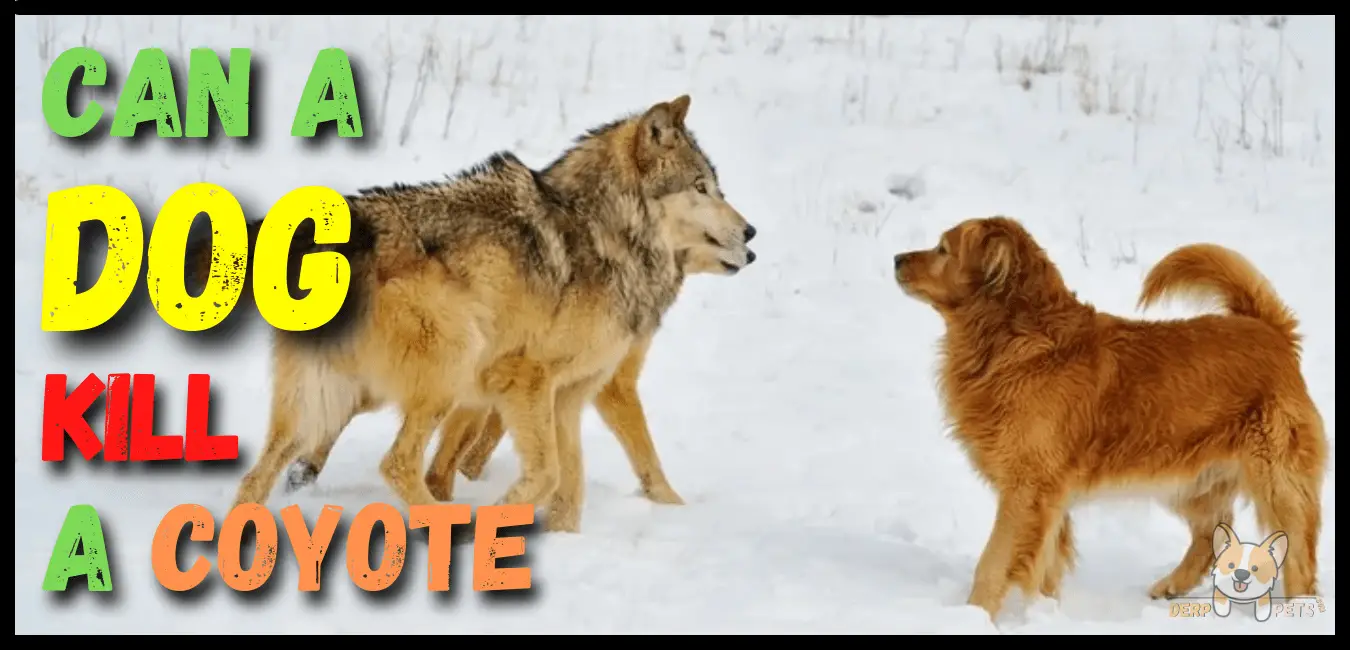
Being a dog owner, you’ll always be worried about your dogs from coyote attacks, especially if you live in the western United States, particularly in California and Arizona.
Can A Dog Kill A Coyote?
Yes, they can, but it literally depends on the dog’s breed, which means big & heavy dog breeds are more likely to kill a ‘single’ coyote. Because the average weight of a coyote is 15 – 46 lbs, so to kill a coyote, the dog’s weight should be around 48 – 60 lbs.
But there are other things to consider as well.
Hang with us for a moment as we go over what you need to know about your Four-Legged Friends and Coyotes.
What Dog Can Beat A Coyote?
The fit and healthy-looking dog with weight the same as a coyote (or more) and the age around 2 to 6 years old can easily overpower a coyote — because dogs this age have all the physical and mental instincts to attack any predators.
Yes, age matters too! Imagine, large breeds like English Mastiff around the age of 10 to 12 years with bad health can beat a coyote, 99.9% possibility they can’t.
Plus, Akita or any other large breed at the age of 10 months to 1 year also can’t beat the coyote.
Because, at that age, dogs probably don’t have any proper instinct to fight with any predator that means they will die in a fight instantly.
But on the other hand, fitness is essential for multiple things, especially when in a fight with a predator.
A dog that is physically fit and active will have a better chance to beat a coyote. So, make your dog healthy and active unless it’s too late.
Which Breed Of Dog Can Kill A Coyote?
As I mentioned above, a dog’s fitness and size matter the most.
But still, there are some big and more powerful breeds than coyotes that can kill coyotes: including Kangal, Komondor, Rhodesian Ridgebacks, Akita, Great Dane & Pyrenees, Beauceron, Bull terrier, Wolfhound, Rottweiler, Greyhounds, Cane Corso, Mastiff, Belgium Malinois, Doberman.
Some of these breeds also have excellent hunting instincts because they were used and bred for hunting purposes! Which makes it hard for a single coyote to kill any of these breeds.
However, a large “way large” pack of a coyote can kill these breeds without a doubt.
Who Would Win In A Fight, A Dog Or A Coyote?
It totally depends on the dog; if the dog is big and fast, there are more chances for the dog to win the fight. But if the dog is small in size and fatty as well, like corgi, pug, and dachshund, then there is 100% surety that the coyote will win the fight instantly.
And you know, both coyotes and dogs have two different goals when it comes to fighting — that truly means dogs fight to dominate their areas, while coyotes fight to kill their enemies or to feed their pups.
However, the average pet dog isn’t prepared to fight with coyotes every time because coyotes are sneaky, evil, clever little killers. Who tricks your dog quickly.
As well as, it also depends on how territorial, strong, and brave your dogs are to fight with coyotes.
Of course, fighting results between dogs and coyotes may vary depending on where you live, as coyotes vary in different sizes depending on where you live.
Because only in the US there are 19 recognized subspecies of a coyote!
Here’s a quick example with nose to tail length of coyotes in different states of US including, Texas: 3.2 to 4.4 foot, Florida: 3.2 to 4.9 foot, Arizona: 2.5 to 3 foot, New York: 4 to 5 foot, Tennessee: 3.8 to 3.9 foot, etc.
Are Coyotes Afraid Of Dogs?
No, they’re not afraid of dogs, but sometimes they avoid fighting with them while trespassing in the yard. It may be because they see humans around the dogs, or maybe the coyote is ill or suffering from wounds.
There is no proper reason why coyotes avoid fighting with domestic pets occasionally, but they do, and that’s the truth.
But that doesn’t mean you can leave your dogs and other pets outside alone for too long because it’s pretty rare to see that coyote avoiding attacking small dogs and pets.
However, coyotes are so notorious for grabbing little dogs out of their backyards and eating them.
Are Coyotes Afraid Of Big Dogs?
Generally speaking, they don’t unless the dog is too large, like Kangal, Great Pyrenees, Wolfhound, and Mastiff. If the dog is the same size as the coyote, the coyote sees them as a rival in their territory, and they will go after them no matter if they get hurt too.
Because coyotes are territorial and they defend their home range (especially during the time of breeding), which typically ranges from 2-5 square miles and bigger.
However, the alpha male and female are the dominant coyotes in their group; and they can go through any possibility if they see their pack members and territory in danger, particularly their young pups.
Other members in the pack are subordinate to the alpha pair. Where subordinate pack members usually care for the young pups of the year, and others help hunt for food.
Do Barking Dogs Scare Coyotes?
Yes, they do be scared by livestock dog barking because livestock dogs are highly trained and good at keeping predators like coyotes away from the flock or herd. But with other pet dogs, it depends on the situation; two or more dogs barking helps to keep coyotes away, except one on one.
Plus, it also depends on the strength, size of the dog! Imagine two or more chihuahuas barking on a coyote — is there any opportunity for them to keep the coyote away, 100% Not”.
Do Coyotes Kill Dogs And Not Eat Them?

Absolutely they do that because coyotes’ primary motive in the attack on domestic dogs is probably to take out a nearby enemy from their territories as possible. And they also eat them if they are hungry enough.
More importantly, coyotes will sometimes travel together or “gang up” to take on enemies. No matter if the enemies are big as mastiff dogs.
If dogs are in their territories during the breeding season, they would definitely go after them, as it’s pretty easy for a pack of the coyote to pick a large dog.
How Big Of A Dog Can A Coyote Kill?
It literally depends on the dog because if the large dog is ill or in his golden year, then a single coyote can surely go after him. Nonetheless, the average size dog who is fit and young can easily defeat the coyote. But coyotes mostly attack small dog breeds like chihuahuas.
However, it’s pretty rare to see a coyote attacking a large dog; coyotes are very clever animals; they generally keep a safe distance from large animals.
But that doesn’t mean they can’t kill large animals — coyotes have the capacity to kill an adult deer in the wilderness, but they primarily hunt deer during the spring season and in the winter.
So be careful and keep your small pets inside, especially at night, because coyotes mostly come out at night for the search of prey.
Why Would A Coyote Attack A Large Dog?
They habitually do that to keep their territory and young members safe from exposure because a large dog resembles them as an opponent for their pack. But they typically attack large dogs during the time of mating in between December and April.
At the time of the breeding season, male coyotes can become highly aggressive because of an increase in testosterone levels.
However, a dog trained to fight, or if the dog knows how to kill an animal efficiently, the dog would be more likely to have a great chance to defend itself from coyotes.
But not all pet dogs have that unusual skill except livestock dogs.
The long and short of it all is that coyotes can always pose a serious risk to your dog in mating season (whether you have a small dog or a large one).
Will A Coyote Attack A Dog On A Leash
Yes, a dog on a leash is more like a treat for coyotes because the leashed dog is easy to catch and kill by a single coyote! Unless the dog is by your side or the leash isn’t tied somewhere else except on the dog’s collar.
Because if the leash is not tied somewhere else, the dog will have a great chance to escape or defend itself from a coyote.
Although, if one end of the leash is tied to the dog’s collar and the other end on the tree trunk, 90% chance the dog will die by shock and suffocation if a coyote attacks because the dog had no opportunity at that time to defend himself.
| Quick Tip |
| If you like to hike with your dog in the wilderness, I’d recommend you take along an air horn or bear repellent spray to keep coyotes away, as coyotes might attack your dog on a leash while you are hiking. |
How Many Dogs Are Killed By Coyotes Each Year
The number is constantly increasing year after year — back in 2018, the number of kills reported was 10 to 15 per year — now it’s around 18 to 25 per year, including other pets, where most kills are recorded during the mating season.
According to experts researchers, almost 30 to 40 different dog breeds and other small pets (like cats, rabbits) were reported to have been killed by coyotes from 2018 to 2020.
Although smaller dog breeds (like pug, chihuahua, and Lhasa apso); were killed more often than medium and large dog breeds.
However, large dog breeds are usually killed by alpha pairs, often a pack of coyotes.
How Often Do Coyotes Attack Dogs?
It depends on the area where you live because every region has its subspecies of coyotes where some are scared of humans, so they maintain a safe distance from them, while others are fearless of humans, which is why they attack pets & dogs twice a week or month.
A fearless coyote mostly attacked small dogs outside in their backyard, even in the presence of their owner.
More often, dogs are mostly attacked during the peak of the mating season in the month of winters and spring.
What Time Of Year Are Coyotes Most Active?
Coyotes are more active during the time of mating season between December and April because, at that time, youngs are looking to pair up with mates to create their own pack.
During the mating season, you can see many wounded coyotes as well — who were not able to find their own territory and mate.

